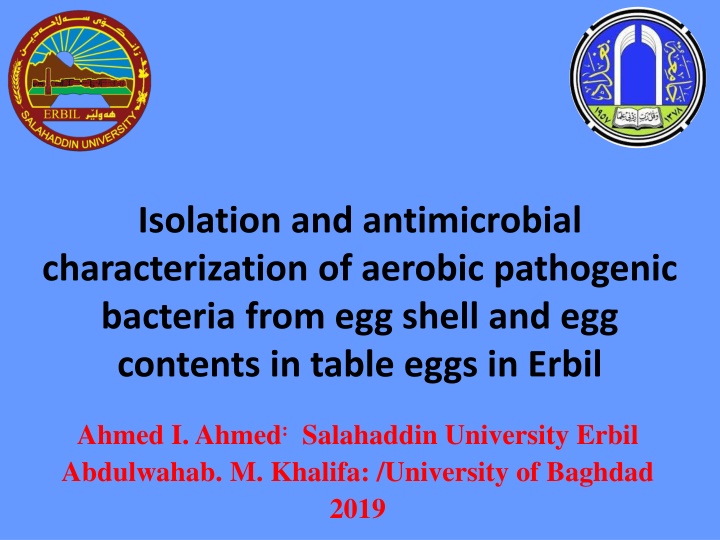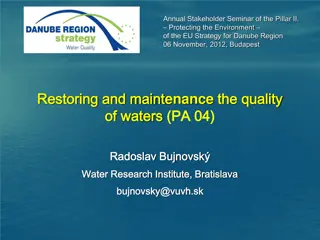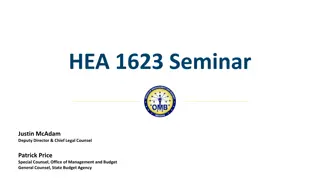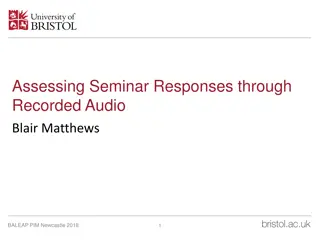
Isolation and Antimicrobial Characterization of Aerobic Pathogenic Bacteria from Egg Shell and Egg Contents
Explore the research on isolating and characterizing pathogenic bacteria from eggshell and egg contents in table eggs in Erbil, shedding light on bacterial contamination levels, risks, and antibacterial resistance. The study focuses on the importance of assessing microbial load in eggs for food safety and highlights the correlation between bacterial contamination and poultry house conditions. Discover the objectives, methods, and findings related to bacterial contamination in fresh chicken eggs in North Iraq.
Download Presentation

Please find below an Image/Link to download the presentation.
The content on the website is provided AS IS for your information and personal use only. It may not be sold, licensed, or shared on other websites without obtaining consent from the author. If you encounter any issues during the download, it is possible that the publisher has removed the file from their server.
You are allowed to download the files provided on this website for personal or commercial use, subject to the condition that they are used lawfully. All files are the property of their respective owners.
The content on the website is provided AS IS for your information and personal use only. It may not be sold, licensed, or shared on other websites without obtaining consent from the author.
E N D
Presentation Transcript
Isolation and antimicrobial characterization of aerobic pathogenic bacteria from egg shell and egg contents in table eggs in Erbil Ahmed I. Ahmed:Salahaddin University Erbil Abdulwahab. M. Khalifa: /University of Baghdad 2019
Introduction Chicken eggs are a healthy food for human ( infants and elderly) which are richest source of proteins, minerals, fat and vitamins. It have been described as the most critical food carrier of pathogenic bacteria mostly in the etiology of food borne disease (salmonellosis) developed countries microbial load of eggs are routinely evaluated before selling, the safety of eggs is important to food poisoning outbreaks
Introduction The total count of aerobic bacterial in poultry houses has been found to be positively correlated with the initial bacterial eggshell contamination. Food-borne diseases occure in most developing countries which pathogenic bacteria in hen house environment have the ability to penetrate the surface of the egg into the egg shell pores. The level of bacteria in the egg shell and internal contents varies greatly due to many factors such as season, stress, stocking density, flock size, individual flock management, farm management, infection from pests and hygiene.
Objectives In North of Iraq little is known about the level of the bacterial contamination in table eggs. The present study was focused on fresh chicken eggs particularly eggshell, egg content to determine the prevalence and level of contamination in process as well as risk of antibacterial resistance of isolated bacteria.
Method The fresh chicken egg were collected from two large scale poultry layer farms followed by Erbil Veterinary directorate Age (Wk) 45 43 43 43 45 43 42 38 Farm System District Flock Capacity Hybird Kawi Qarachux Cage Kawi Qarachux Cage Kawi Qarachux Cage Kawi Qarachux Cage Kawi Qarachux Cage Hayat Altaaba Hayat Altaaba Hayat Altaaba Qushtapa Qushtapa Qushtapa Qushtapa Qushtapa Shamamk Shamamk Shamamk H1 H2 H3 H4 H5 H1 H2 H3 120000 62500 62500 62500 62500 54000 54000 54000 ISA Brown ISA Brown ISA Brown ISA Brown ISA Brown Lohmann Hy-Line Tetra Cage Cage Cage
Method Eggshell contamination: total count of aerobic bacteria and selected colonies sub-cultured on EMA agar for E coli and XLD agar for Salmonella and MSA for staphylococcus uraus identification. Internal egg contents contamination: egg contents were Pooled and homogenized, 5 ml of homogenate was mixed to 45mL of (0.1%) BPW in a zip-lock bag as described by Samiullah et al 2014 100uL Plated on each NA, McA and MSA Environmental swab:Sterile swabs were taken from cages directly. transferred into 10uL the 0.1% BPW and incubated, cultured on NA and incubated, suspected colonies , sub cultured on specific media for specific organism Bacterial characterization: Bacterial identification was using into the appropriate VITEK 2 ID and AST cards the procedures were strictly followed by manufacturer .
Results Evaluate the microbial quality of chicken eggs before selling, total bacterial count on its eggshell Kawi Qarachux project layer Hayat Altaaba project layer 6.114 6.2 5.964 Bacterial load log cfu/egg 6.2 6 5.248 5.224 5.174 5.138 5.078 5.792 Bacterial load log cfu/egg 5.2 5.71 5.7 5.8 4.2 5.6 5.476 3.2 5.4 5.296 2.2 5.2 1.2 5 0.2 4.8 H1 H2 H3 Belt egg -0.8 H1 H2 H3 H4 H5 Belt Storage storage site of sample Site of sample
Results Table (2) Represented bacterial isolates, differential culture media, staining and Vitek2. Total bacteria Staphylococcus Enterobactereaca E-coli Others gram negative Salmonella Media Blood agar, MSA MacConkey agar EMB agar MacConkey agar XLD agar Biochemical test Coagulase ve Vitek 2 system Vitek 2 system Vitek 2 system Vitek 2 system test Stain Gram + Gram - Gram - Gram - Gram - Table (3) Determination of overall prevalence of bacterial pathogens Total no of pathogens isolated from different samples with Percentage 27 (54%) 0 (00.0%) 5 (41.66%) 32 (44.44%) Total number of positive isolates Name of samples Citrobacter freundii 1 0 0 1 (1.38 %) Enterobacter aerogenes 5 0 0 5 (6.94 %) Enterobacter cloacae 2 0 0 2 (2.76 %) Staphylococcus spp. E. coli Egg shell (50) 69.4% Egg content (10) 13.9% Cage swab (12) 16.7 Total (72) 100% 6 0 2 13 0 3 8(11.11%) 16 (22.22 %)
Results Table (4) Determination of overall prevalence of bacterial pathogens Description of VITEK2 MIC (mg/L)/ category of susceptible of AST-GN69 results of isolated gram negative bacteria AMX/ CLA AMP/ SUL PIP/T AZ AMP CFZ CAZ CRO CEF ETM IMP GEN TOB CIP LEV ( 0.5) S ( 0.25) S ( 8 ) S ( 1) S 6 ( 32) R ( 32) R ( 8) S ( 64) R ( 1) S ( 1) S ( 1) S ( 1) S ( 4) R ( 8) R E coli Enterobacte r aerogennes 5 (16) R ( 0.5) S (0.5) S ( 1 ) S ( 1 ) S (64) R ( 4) S ( 64) R ( 1) S ( 1) S ( 1) S ( 1) S ( 1) S - ( 0.25) S Enterobacte r Cloacae ( 8 ) S ( 8 ) S ( 0.5) S ( 1 ) S ( 2 ) S (64) R 2 ( 32) R ( 64) R ( 1) S ( 1) S ( 1) S ( 1) S - Citrobacter freundii (64) R 1 ( 2) S ( 2) S ( 4) S ( 4) S ( 1) S ( 1) S ( 1) S ( 0.5) S ( 0.25) S ( 1) S ( 1) S ( 4) R ( 8) R
Results Table (5) Determination of overall prevalence of bacterial pathogens Mean SE of Hardness, thickness of the eggshell with different of bacterial load Cfu/ml log for the different flocks Hardness Mean SE kg/cm 0.936 0.217 b 1.235 0.098 ab 1.441 0.165 ab Thickness Mean SE mm 0.316 0.069 b 0.392 0.010 ab 0.393 0.008 ab bacterial load Cfu/ml log Mean SE 4.404 0.734 b 5.078 0.103 ab 5.174 0.071 ab Egg sample Lohmann Hy-Line Tetra brown Egg storage Hayat altaaba ISA Brown Conveyer Belt Kawi Qarachux Egg storage Kawi Qarachux 1.202 0.115 ab 0.452 0.036 a 5.248 0.012 ab 1.304 0.103 ab 0.388 0.005 ab 5.728 0.064 a 1.544 0.156 a 0.420 0.024 a 5.710 0.038 a 1.255 0.125 ab 0.463 0.042 a 5.700 0.045 a Table (6) Determination of regression between Hardness, thickness of the eggshell with different of bacterial load Cfu/ml log for the different flocks R2 bacterial load Cfu/ml log Mean SE Y=a+b1xh Y= a+b2xth Y= a+b1xth +b2xth Hardness Thickness Hardness+Thickness 0.10 0.41 0.43
Conclusion This study were provide the recent dataset of the prevalence of Sataphyloccocus and E. coli in fresh chicken egg at hen houses in Kurdistan-Iraq. Bacterial load on egg shell were at the accepted level Isolation of pathogenic bacteria due to lack of hygiene practice were attention. We recommend that the farmer must fumigate the fresh eggs with a good hygienic practice before marketing.






















